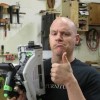Hey all, I still haven't decided on what my new plane purchase will be (reference a 2 page thread I started a few days ago), but last night, I was watching a youtube video where a guy from Lie Nielsen was setting up a brand new chisel. He said that their stuff comes really flat, but almost always needs a little tuning, and he mentioned that planes are no exception.
For fun today, I took my LV Apron plane and ran it across a 1200g diamond stone a couple dozen times. I discovered that it was not totally flat! I took it to some 320 grit paper on a granite block to get it flat, but then realized I had opened up the question well. How shiny/polished should the bottom of a plane be?
Also, I know the preferred method is to use a granite block with sandpaper, but one thing I noticed is that the paper does not sit perfectly flat on the granite. Because of this, as you move the plane around on the paper, it creates almost a ripple in the paper which leads the plane. What I notice is that the bottom is flat, except for the very outer 1/16" of the sole's circumference. That area is beveled up a slight bit. Normal?





 Reply With Quote
Reply With Quote




